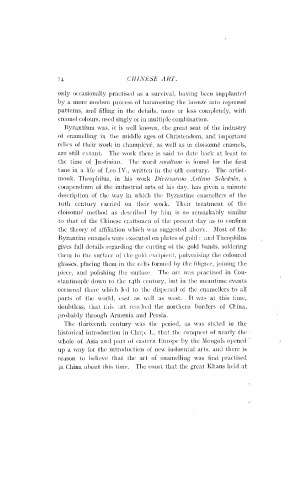Page 256 - Chinese Art, Vol II By Stephen W. Bushell
P. 256
74 CHINESE ART.
only occasionally practised as a survival, having been supplanted
by a more modern process of hammering the bronze into repousse
patterns, and filling in the details, more or less completely, with
enamel colours, used singly or in multiple combination.
Byzantiiun was, it is well known, the great seat of the industry
of enamelling in the middle ages of Christendom, and important
relics of their work in champleve, as well as in cloisonne enamels,
are still extant. The work there is said to date back at least to
the time of Justinian. The word smaltum is found for the first
time in a life of Leo IV., written in the gth century. The artist-
monk, Theophilus, in his work Diversarum Artiiim Schedula, a
compendium of the industrial arts of his day, has given a minute
description of the way in which the Byzantine enamellers of the
loth century carried on their work. Their treatment of the
cloisonne method as described by him is so remarkably similar
to that of the Chinese craftsmen of the present day as to confirm
the theory of affiliation which was suggested above. Most of the
Byzantine enamels were executed on plates of gold : and Theophilus
gives full details regarding the cutting of the gold bands, soldering
them to the surface of the gold excipient, pulverising the coloured
glasses, placing them in the cells formed by the filigree, joining the
piece, and polishing the surface. The art was practised in Con-
stantinople down to the 14th century, but in the meantime events
occurred there which led to the dispersal of the enamellers to all
parts of the world, east as well as west. It was at this time,
doubtless, that this art reached the northern borders of China,
probably through Armenia and Persia.
The thirteenth century was the period, as was stated in the
historical introduction in Chaj). I., that the conquest of nearly the -
'
whole of Asia and part of eastern Europe by the Mongols opened
up a way for the introduction of new industrial arts, and there is
reason to believe that the art of enamelling was first practised
in China about this time. The court that the great Khans held at

